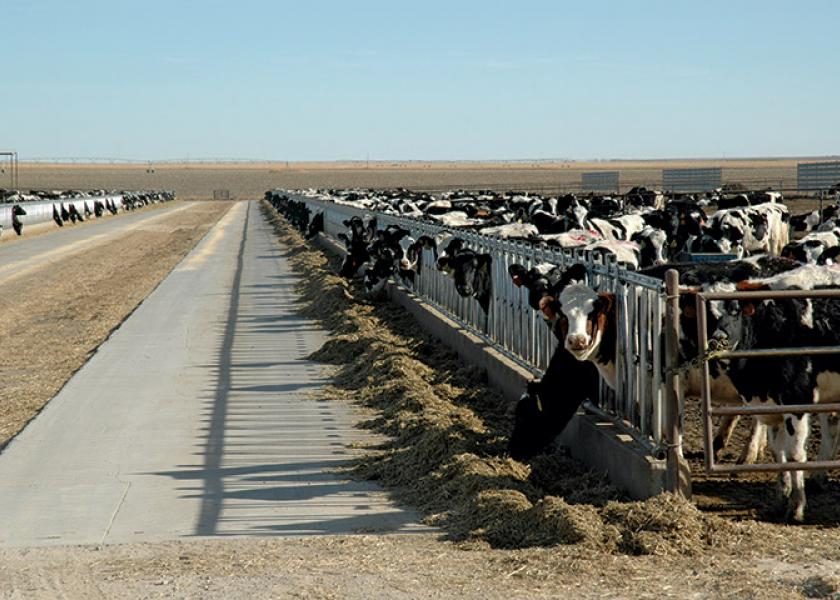Precision Feed Heifers

The approach cuts costs and boosts feed efficiency
The 11th commandment for dairy farmers and heifer growers is: Thou shalt have feed in front of heifers 24 hours a day.
However, research during the past decade is proving that edict false. If followed, 24-hour feed availability leads to overconditioned heifers, poor feed efficiency and unnecessarily high feed costs.
With modern heifer-raising facilities that limit environmental stress and provide high-quality diets, heifers must somehow be limit-fed, says Jud Heinrichs, a nationally recognized expert on heifer raising based at Penn State University. "With good facilities and high-forage-quality rations, we don’t need feed in front of heifers more than six to eight hours per day," he says.
Bonus Content | |
| More on precision feeding heifers |
"We’re often reminded of the importance of feed efficiency for lactating dairy cows, yet the concept is seldom mentioned for the growing heifer," he adds. "However, dairy animals spend over half of their life on most farms as a calf or heifer, which means feed efficiency is critical, as well."
Limit-feeding increases the digestibility of the ration being fed because it slows the rate of passage of that feed through the animal. As a result, you’ll gain 20% to 30% in feed efficiency, which represents significant feed cost savings, Heinrichs says.
Rations must still be carefully balanced to ensure heifers are receiving needed protein and energy; see table at right. But diets can easily be formulated to meet these needs, ensuring heifers are growing properly while saving feed costs.
Key to precision feeding is weighing heifers regularly to ensure they’re meeting growth targets, Heinrichs says. "An inappropriate level of diet restriction can lead to rapid gains and fat heifers, or gains lower than desired," he says.
Weighing heifers once a month is best. Once your system is established, less frequent weighing works as long as you monitor body condition.
Always "weigh heifers at the same time of day [relative to feeding]; otherwise, alterations in gut fill can impact average dairy gain calculations," Heinrichs says.
Heifers must also be grouped with similarly sized animals for precision feeding to work. Otherwise, larger animals can prevent smaller animals from accessing feed.
From four months of age until breeding, Heinrichs recommends a weight variation no greater than 200 lb., with age variation of no more than two to four months. "Post breeding, this number can be increased to 300 lb. weight spread between animals within a group," he says.
And because animals won’t have access to feed all day and night, bunk space is critical. "Heifers will need 14" to 24" of feedbunk space per heifer as they progress from four months of age to pre-calving or 22 months of age," he says.
Young calves, when transitioned from full access to feed in weaning groups to precision feeding in grower groups, will voice their displeasure. But the behavior will stop between 10 and 14 days after the change is made.
At the other end of the growing period, heifers should be transitioned to normal, full-access, pre-freshening diets 30 to 45 days before calving.
"Changes in rumen and gut volume have been shown to occur rapidly and do not limit post-calving dry matter intake," Heinrichs explains.
"Precision feeding heifers until 30 to 45 days before calving has had no adverse effects on calf birth weight, dystocia, metabolic problems, early lactation feed intakes, or first-lactation milk production."
Heinrichs says the final determination of success is the animal herself. "I have zero tolerance for heifer dystocia, so heifers have to be well grown," he says.
Heifers should be 750 lb. to 800 lb. at breeding and 1,300 lb. to 1,375 lb. at calving. If you meet these targets, heifers will do fine. "Getting heifers larger than that shows no good benefit," Heinrichs says.
Customized Heifer Growth Charts
Penn State University dairy scientists have developed a fully customizable spreadsheet that will develop a heifer growth chart specific to your farm.
Most heifer growth charts are compared to breed standards, but these standards might not be applicable to your farm, where your genetics could be programming for larger or smaller animals than the breed average. In addition, crossbred heifers are difficult to benchmark since they often vary between breed standards.
The spreadsheet allows you to enter your own herd’s goals for age at first calving and the mature size of animals in your herd. It assumes a target body weight of 55% of mature weight at first conception and 85% of mature weight at first calving. Height targets are 55% of mature height at birth, 85% of mature height at conception and 96% of mature height at calving.
To build the growth charts, you’ll need to enter average body weight and height of third-lactation cows in your herd, average birth weight of calves, average services per conception for heifers and your goal for age at first calving. The spreadsheet then develops heifer growth goals.
Go to the bonus content for this article at www.dairytoday.com to access the growth chart spreadsheet.








